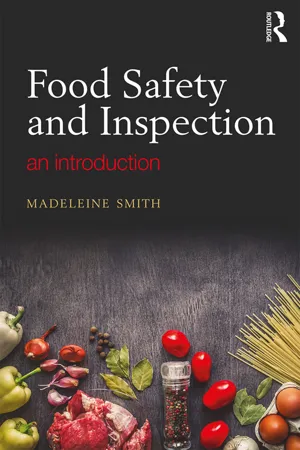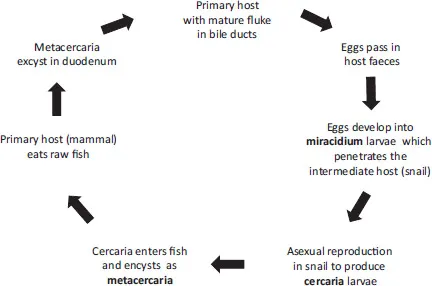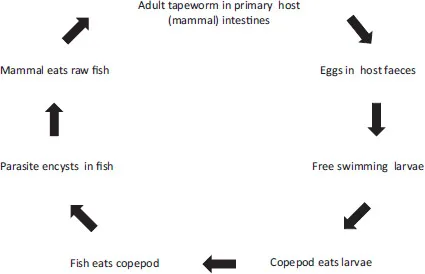![]()
1 Parasites associated with fish
A parasite is defined as an organism that lives in or on another organism, deriving shelter and/or nutrition from the host. Typically the parasite receives benefit from the relationship, but the host does not. The host is usually disadvantaged by the relationship, although it is not normally in the interests of the parasite to affect the host so badly that the host dies prematurely. Parasites associated with fish are mainly worms. There are two important phyla of worms that contain parasitic members. These are the flatworms (Platyhelminthes) and the roundworms (Nematoda).
Platyhelminthes (flatworms)
There are three classes of flatworms but only two are parasitic: the trematodes (liver flukes) and cestodes (tapeworms). Platyhelminth worms are ideally adapted to a parasitic life style as they are often small flattened creatures with fairly simple organ systems. They have only one opening to the digestive tract (or in the case of tapeworms, no digestive tract at all) and some rely on nutrients passing across the body wall or tegument. The body wall is also the site where gaseous exchange occurs, there being no equivalent of a lung. Nitrogenous waste is also passed across the tegument. Species that are endoparasitic (all those described here) are facultative anaerobes since the oxygen supply within a host’s organ systems will be limited.
Both classes have marine and freshwater representatives and typically have quite complex life cycles. Unlike meat, there is not a universal system of inspection that can control the hazard of parasites in fish prior to placing on the market. This means that in some parts of the world they are a significant source of morbidity.
Trematoda (liver flukes)
As their common name implies, the adult form of this class inhabits the liver of the primary host. The primary host is typically a mammal, and the adult parasite infests the host’s bile ducts, causing thickening, inflammation and blockage. The adult worm is small (usually only a couple of centimetres long) and flattened. Many have hooks around the edge of the body to assist their movement through the bile ducts of the host liver. This action contributes to the irritation and discomfort associated with the infestation. Substantial numbers of the parasite can build up in a host, causing blockages of the bile ducts.
The parasites have multi-stage life cycles involving intermediate hosts. The intermediate hosts contain the juvenile or intermediate stages of the worm. The primary host (a vertebrate) contains the adult. Trematodes are hermaphrodites. Eggs from the adults are deposited into water and a free-swimming larva known as a miracidium develops. This penetrates the epidermis of the intermediate host and goes through various developmental stages there, typically in the digestive gland. The developed larva (cercaria) will leave the host via the digestive system and is usually eaten by a second intermediate host, where it encysts to form what is known as the metacercaria. The life cycle is completed when the second intermediate host is eaten (raw) by the primary host. The metacercaria then excysts and migrates to its target spot, where it matures into an adult worm.
There are an estimated 70 species of trematodes that affect humans via food sources (WHO 2002) and a number of these species of liver fluke use fish as one of their intermediate hosts. They include Clonorchis sinensis (Chinese liver fluke) and
Opisthorcis felineus (Siberian fluke). Clonorchis sinensis is endemic in China, Japan, Korea and Taiwan (Kaewpitoon et al. 2008). In Thailand O. viverrini is the native parasite, and in Eastern Europe it is O. felineus (Kaewpitoon et al. 2008). All have very similar life cycles involving two intermediate hosts (a fish and a mollusc) with a mammal (human) as a primary host. The mature worms can be very long-lived, surviving in the bile ducts for up to ten years in some cases. The life cycle of a typical trematode Clonorchis sinensis is shown as an example (Figure 1.1).
The key issue is that the primary host (the mammal) must eat the second intermediate host (the fish) raw. Cooking destroys the metacercaria larva and no infection will occur. Metacercariae survive and remain viable in the raw product for a number of hours after the fish dies. This strategy is presumably to maximise the opportunity for infecting the primary host. Freshly killed raw fish are the most dangerous but chilling or freezing can in fact prolong the viability of the larvae. Wiwanitkit et al. (2001 and 2002) found that refrigeration and freezing slow the degeneration of the metacercaria to between 5 and 8 hours. They estimate that it may take up to 12 hours after the fish dies for the larvae to fully degenerate under chilled conditions.
Wiwanitkit et al. (2002) estimated there were approximately 21 million cases of human infection by liver flukes worldwide, although this is difficult to assess accurately. There is a high prevalence of trematode parasites in South East Asia, mainly due to the popularity of eating raw fish, especially very freshly killed fish. A survey of 79 fish in a Thai reservoir found that a substantial number (16 fish or 20%) were infected with active metacercariae (Wiwanitkit et al. 2001). Infection with liver flukes will normally cause at least abdominal pain and indigestion, and often more serious symptoms such as diarrhoea; jaundice; gastrointestinal bleeding; formation of gallstones; enlarged gall bladder; weakness and weight loss; portal hypertension; ascites; inflammation and hyperplasia of the biliary epithelium leading to deposition of fibrous tissue. Anorexia has also been reported and, in heavy infections of Clonorchis sinensis, there may be an invasion of the pancreatic duct (WHO 2002). Faecal screening can be carried out, but the organism may be difficult to detect in new cases or where infestation is light (WHO 2002). Treatment can be carried out using antihelminths such as praziquantel (Wiwanitkit et al. 2001, 2002).
Figure 1.1 Life cycle of Clonorchis sinensis
Control
The best control is the thorough cooking of all fish prior to eating. However, raw fish is a traditional delicacy in many parts of the world and is increasingly popular in the UK and USA (Terramocci et al. 2001). As mentioned already, the larvae remain infective for some hours after the fish is killed, and chilling prolongs the viability. Fan (1998) found viable metacercariae after freezing the infested fish for up to seven days at -200C. In this experiment 100% of the laboratory rats used for testing were found to be infected by the pre-frozen larvae. In a similar experiment where the fish were frozen for 18 days at-120C, the same researcher found a 75% infection rate in rabbits. Under experimental conditions, drying (air) and/or marinating in 5% vinegar or 5% NaCl appear to speed up the destruction of the metacercariae. After three hours at room temperature, the larvae had degenerated (Wiwanitkit et al. 2002). This suggests that the traditional condiments of salty fermented sauces (soy sauce or fish sauce) and vinegar, which often act as a marinade or accompany raw fish dishes, might provide a hurdle, but are not on their own sufficient to destroy the larvae if the fish is to be eaten very fresh. It should also be noted that there is conflicting evidence. Fan (1998) found viable and infective larvae after salting fish at room temperature for up to seven days. He used a salt concentration of 3g salt /10g fish, which seems extremely high compared to the work reported by Wiwanitkit et al. (2002). However, Fan reports that larvae still infected 100% of the laboratory rats used to test viability after this treatment.
The disposal of human sewage is another issue for the life cycle of these liver flukes. The eggs from the adult trematode are passed in the faeces of the mammalian (human) host. If the human and animal faeces are treated and controlled, the life cycle of this parasite will be interrupted. However, in some countries raw human sewage is still allowed to contaminate water courses. In fact, according to the WHO report (2002), many rural households have a pool or pond in which to raise fish for their own (or others’) consumption. Householders deliberately add human and animal excrement to the pool as a fertiliser. The report describes the ‘widespread use of latrines constructed on stilts directly over fishponds or beside them’ and suggests this is a major source of contamination with regard to trematode infection. It is difficult to disagree with this conclusion.
Destruction of snails has also been suggested by the WHO as a possible control measure. However, as the larval stages inhabit several species of snail (and several species of fish) (Kaewpitoon et al. 2008), correct disposal of human sewage would probably be a more effective option – and would also interrupt the transmission of many other diseases passed via the faecal-oral route, in addition to limiting trematode infections.
Cestoda (tapeworms)
The cestodes are tapeworms, and there are several species where the primary host is a mammal. The intermediate hosts are usually a crustacean and a fish. As with the trematodes, the fish (second intermediate host) must be eaten raw by the primary host (mammal) for infection to occur. Diphyllobothrium latum is a well-reported tapeworm that uses fresh water crustacean and fish as intermediate hosts.
Diplogonoporus grandis is also reported as causing morbidity, but less appears to be known about this organism. The life cycle of Diphyllobothrium latum is shown as a typical example of the group (Figure 1.2).
Diphyllobothrium latum is a long-lived parasite which has been known to inhabit human hosts for up to 20 years. During that time it can grow to significant size in the host’s small intestine, for example, 15 meters (Raether and Hänel 2003). It is commonly but not exclusively found in cold water fish, and infections have been reported in North and South America, Russia, Japan and Europe (Raether and Hänel 2003, Terramocci et al. 2001) as well as warmer countries such as Korea (Lee et al. 2001). Given the organism’s freshwater distribution, fish with a high risk of transmitting the parasite include pike, perch, ruffe and turbot, as well as the salmonids (Raether and Hänel 2003, Terramocci et al. 2001, Lee et al. 2001). There are marine species in this group as well. Kino et al. (2002) reported 46 cases of Diplogonoporus grandis in Japan in 1996, some of which appear to have been caused by the consumption of raw juvenile anchovies. Other suspected sources include raw tuna and jack mackerel.
Figure 1.2 Life cycle of Diphyllobothrium latum
Humans who are infected with D. latum may show few symptoms. The ripe proglottids pass in the faeces and can be noticed, but there is apparently very little discomfort associated with the process. According to Raether and Hänel (2003), approximately 2% of infected individuals develop pernicious anaemia as a result of the parasite. Kino et al. (2002) found symptoms in many of the participants in their study of Diplogonoporus grandis. However these were relatively mild, the main symptom being diarrhoea (94.6% of participants). Other symptoms included abdominal pain, fever and vomiting and, in one case, perhaps unsurprisingly, ‘a strange abdominal feeling’. Patients became aware of the infection when the worms spontaneously evacuated. The patients then presented themselves for medical treatment. Similarly in the incidents reported by Terramocci et al. (2001) of D. latum infections in Italy, the victims were either asymptomatic or displayed mainly diarrhoea and/or abdominal pain.
As with trematode infestation, the distribution of illness relates to the culture of eating raw fish. Lee et al. (2001) report two cases of D. latum in Korea from eating raw cherry salmon and Terramocci et al. (2001) report six cases of D. latum around Lake Como, Italy, between September 1998 and December 1999 from raw perch. Other more recent incidents can be found in the literature from various parts of the world and researchers suggest that increasing numbers are coming to the attention of medical staff. Part of this might be due to the development of aquaculture which can introduce a species to areas where it was previously unknown. This appears to have happened in South America where incidents of the disease are reported in both Brazil and Chile, although the parasite is not native in Brazil (Cabello 2007). It is suggested that the escape of salmonids from aquaculture tanks has provided the opportunity for the parasite to infect native fish and the practice of exporting fish to Brazil has allowed the parasite to infect people in places where it is not endemic. The other practice that is increasing the incidence of this parasite is the increase in the popularity of raw fish dishes, such as sushi, in areas where it was not traditional (Terramocci et al. 2001).
Control
As with trematode parasites, the best control is to cook fish before eating. This destroys the encysted larvae. One of the six patients in Italy described by Terramocci et al. (2001) claimed to have eaten smoked rather than raw fish. Torres et al. (1989) also suggest that smoked fish can be a source of infection. Unfortunately, unlike the trematodes, there is little recent published experimental data giving any information about the longevity of the encysted larvae or their resistance to heat, cold, acid or salt. It does not appear from the notified cases that cold smoking will kill the larva, but the temperatures used were not reported. It is possible that freezing and/or salting can have a detrimental effect on viability, but there is no published data to indicate appropriate temperatures, times or concentrations. Given the larvae’s ability to survive gastric juices, they are likely to have some survival mechanism to withstand low pH. The conclusion must be that only thorough cooking can be confirmed as an effective control. Further research might identify a safe freezing time/temperature...


